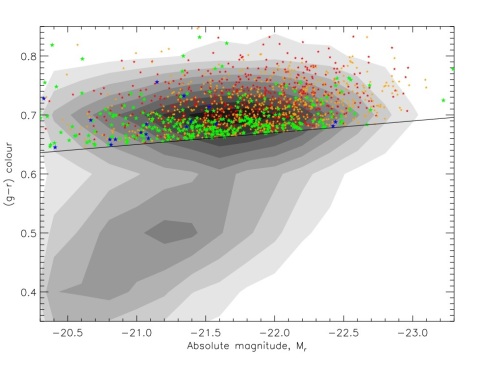Grossly wrong Petro_R50 values mean that corresponding Abs_r values are also hopelessly wrong
-
 by
JeanTate
by
JeanTate
I expect that "grossly wrong Petro_R50 values mean that corresponding Abs_r values are also hopelessly wrong" is quite uncontroversial; after all, the value of r (in mags) which the calculation of Abs_r (the estimated absolute magnitude of a galaxy, in the r-band1) is based on 'modelMag_r', the SDSS photometric pipeline's estimate of the galaxy's r-band magnitude. These 'modelMag's are derived by fitting a 1D profile to the distribution of the galaxy's light (either deVaucouleurs or exponential), and extrapolating/truncating. Central to this is a reasonable 'de-blending' of multiple, overlapping objects. The de-blender - a very clever part of the photometric pipeline - also produces an estimate of Petro_R50.
Why does this matter?
One of the workhorses of this part of extra-galactic astronomy (as I understand it, which I am the first to admit I do not, very well) is the color-magnitude diagram. In which the x-axis is (often) Abs_r - a.k.a. Mr - or something very similar. For example, the second hit on my Google search turned up this, which is in a Galaxy Zoo blog post by Karen Masters (source):

So how bad can it get? And how common are grossly wrong values of Petro_R50 in the QS catalog? The QC catalog?
That's what I would like to explore in this thread; I hope you'll join in.
1 Sorta; in GZ1 these were k-corrected, but not in GZ2; my guess is that we, in the Quench project, are following GZ2
Posted
-
 by
mlpeck
by
mlpeck
Sorta; in GZ1 these were k-corrected, but not in GZ2; my guess is that we, in the Quench project, are following GZ2
I finally found an explicit statement that magnitudes from the photo pipeline are not corrected for galactic extinction: http://www.sdss3.org/dr10/algorithms/magnitudes.php#extinction. I'm quite sure they aren't k-corrected either, but I haven't found a definitive statement.
Posted
-
 by
JeanTate
in response to mlpeck's comment.
by
JeanTate
in response to mlpeck's comment.
However, there is a set of fields for galactic extinction.
In DR9 for example, there are five "extinction" fields in PhotoObj, "extinction_x", where x is one of u, g, r, i, z. Also five "dered" ones, "dered_x", which are the model mags minus the extinctions. The SDSS photometric data does not include a k-correction (not sure about DR10 though; haven't checked).
I don't think there's been any statement, by any SCIENTIST (Quench project or otherwise), on how the "Abs_r" values were derived.
And how common are grossly wrong values of Petro_R50 in the [...] QC catalog?
In the first - smallest - 100 QC objects, there are ~12, which is a proportion far higher than I'd've expected. See this post for details.
Posted
-
 by
mlpeck
by
mlpeck
I don't think there's been any statement, by any SCIENTIST (Quench project or otherwise), on how the "Abs_r" values were derived.
Are you referring to the abs_r values tabulated in the quench and control sample data tables? I'm not a SCIENTIST but I can reverse engineer what they did easily enough. They calculated the distance modulus corresponding to the luminosity distance implied by the redshift and subtracted it from the apparent r magnitude. No other corrections were applied.
The cosmological parameters they used were H0 = 71.81 and Ωm = 0.27261.
As I said before I think the ugriz magnitudes are just the modelMag's, with no galactic extinction or k corrections applied. It would be better to do both, to be sure. Galactic extinction is easy enough since it's tabulated in the photometric pipeline tables. I think you'd have to go outside the SDSS data processing to get k corrections though.
1Oddly enough if I plug exactly those values into my own cosmological distance calculator I get the same absolute magnitudes to nearly machine precision as the tabulated values. The GZ2 paper uses H0 = 71.8 and Ωm = 0.273. I don't know where the extra significant digit in the input parameters came from. Maybe they just rounded off the values of c and the number of centimeters in a megaparsec to a different number of digits than I did.
Posted
-
 by
JeanTate
in response to mlpeck's comment.
by
JeanTate
in response to mlpeck's comment.
I don't think there's been any statement, by any SCIENTIST (Quench project or otherwise), on how the "Abs_r" values were derived. - me
.
Are you referring to the abs_r values tabulated in the quench and control sample data tables? I'm not a SCIENTIST but I can reverse engineer what they did easily enough. - mlpeck
Clearly, my memory is not what it once was 😦 Here's an exchange, over three posts, in the Tools: questions, issues, and comments thread:
Abs R: the true brightness (absolute magnitude) of the galaxy in r-band, based on its apparent brightness and distance from us. Units are magnitudes. - KWillett
"Abs R: the true brightness (absolute magnitude) of the galaxy in r-band" - corrected for (foreground, galactic) extinction (a.k.a. reddening)? K correction applied (or not)? If so, which? - me
Absolute magnitudes are corrected for Galactic extinction and are k-corrected to z=0. - KWillett
Posted
-
 by
mlpeck
in response to JeanTate's comment.
by
mlpeck
in response to JeanTate's comment.
"Abs R: the true brightness (absolute magnitude) of the galaxy in r-band" - corrected for (foreground, galactic) extinction (a.k.a. reddening)? K correction applied (or not)? If so, which? - me Absolute magnitudes are corrected for Galactic extinction and are k-corrected to z=0. - KWillettThis can only be true if the apparent magnitudes are corrected for extinction and k-corrected, which I doubt is the case. If the absolute magnitudes (but not apparent magnitudes) were extinction and k-corrected I could not have gotten 10+ digit agreement with the tabulated absolute magnitudes just by subtracting distance moduli and with a bit of trial and error fiddling of cosmological parameters.
Posted